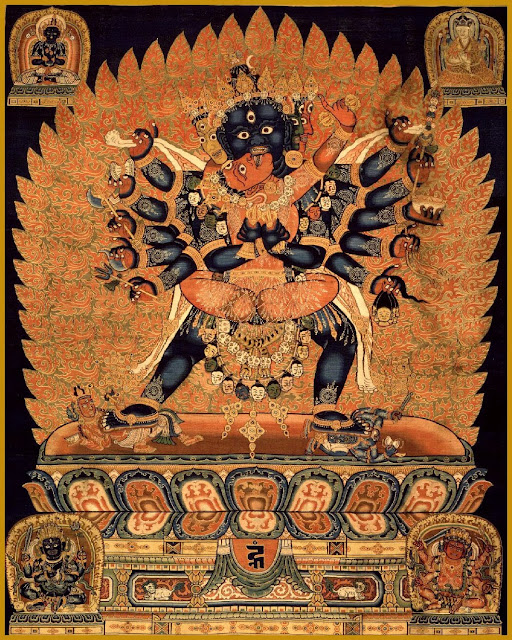Bhagavan Chakrasamvara
The Cakrasaṃvara Tantra, Chinese: 胜乐金刚 shènglè jīngāng; Tibetan: Khorlo Demchog Gyud (Tibetan: འཁོར་ལོ་སྡོམ་པ / བདེ་མཆོག, Wylie: khor lo sdom pa / bde mchog gi rgyud) is considered to be of the mother class of the Anuttara Yoga Tantra in the Indo-Tibetan Vajrayana Buddhist tradition.
The central deity of the mandala, Samvara, is one of the principal iṣṭha-devatā, or meditational deities of the Sarma schools of Tibetan Buddhism.
Samvara is typically depicted with a blue-coloured body, four faces, and twelve arms, and embracing his consort Vajravarahi (in Chinese 金刚亥母 jīngāng hàimǔ)in the yab-yum position. Other forms of the deity are also known, with varying numbers of limbs. Saṃvara and consort are not to be thought of as two different entities, as an ordinary husband and wife are two different people; in reality, their divine embrace is a metaphor for the union of great bliss and emptiness, which are one and the same essence.
Samvara manifests in a number of forms, including a two-armed form. As one of the principal yidams of the Kagyupa lineage of Tibetan tantric Buddhism, he is most often depicted in this form and in union with the red Wisdom Dakini Dorje Phagmo. In Western meditation texts the name Cakrasamvara or Korlo Demchog is often translated to mean Highest Bliss. Meditation on Korlo Demchog is an advanced practice transmitted by one's lama, and binds the mind of the meditator to enlightenment itself.
Chakrasamvara (Tibetan: khor lo dem chog. English: the Wheel of Bliss). The principal tantra of the Anuttarayoga Wisdom (mother) classification of the Vajrayana Buddhist Tradition. Chakrasamvara is one of the most popular deities in Tantric Buddhism in the Himalayan regions and Tibet after the 11th century. He can appear in several dozen different forms, from simple to complex and peaceful to wrathful, which makes it necessary to rely on the descriptive literature in the Sanskrit and Tibetan languages to identify him. Adding to the complexity, there are more than fifty different traditions of these forms in Tibetan Buddhism. They are meant to emphasize different types of meditation practice that are suited for specific types of emotional and psychological characteristics in the tantric practitioners who take on these intricate practices.
Tantric Deties such as this. Most of the people mistake them as sexual art but it is not. In fact it had deeper meaning in them in very deep meditation symbol meaning: the male stand for the right male channel the sun channel pingala nandi while the female left moon channel Ida Nadi. when both union of male & female it is the union of these two channel to the middle channel called Sushumna Nadi is three channels in one, one inside the other which link to 7 major chakra that runs in the spinal cord it lead us to the total enlightenment. This Mediation usually being Called KUNDALINI YOGA (UNION of SHIVA [CHAKRA] & SHAKTI [ENERGY])
The central deity of the mandala, Samvara, is one of the principal iṣṭha-devatā, or meditational deities of the Sarma schools of Tibetan Buddhism.
Samvara is typically depicted with a blue-coloured body, four faces, and twelve arms, and embracing his consort Vajravarahi (in Chinese 金刚亥母 jīngāng hàimǔ)in the yab-yum position. Other forms of the deity are also known, with varying numbers of limbs. Saṃvara and consort are not to be thought of as two different entities, as an ordinary husband and wife are two different people; in reality, their divine embrace is a metaphor for the union of great bliss and emptiness, which are one and the same essence.
Samvara manifests in a number of forms, including a two-armed form. As one of the principal yidams of the Kagyupa lineage of Tibetan tantric Buddhism, he is most often depicted in this form and in union with the red Wisdom Dakini Dorje Phagmo. In Western meditation texts the name Cakrasamvara or Korlo Demchog is often translated to mean Highest Bliss. Meditation on Korlo Demchog is an advanced practice transmitted by one's lama, and binds the mind of the meditator to enlightenment itself.
Chakrasamvara (Tibetan: khor lo dem chog. English: the Wheel of Bliss). The principal tantra of the Anuttarayoga Wisdom (mother) classification of the Vajrayana Buddhist Tradition. Chakrasamvara is one of the most popular deities in Tantric Buddhism in the Himalayan regions and Tibet after the 11th century. He can appear in several dozen different forms, from simple to complex and peaceful to wrathful, which makes it necessary to rely on the descriptive literature in the Sanskrit and Tibetan languages to identify him. Adding to the complexity, there are more than fifty different traditions of these forms in Tibetan Buddhism. They are meant to emphasize different types of meditation practice that are suited for specific types of emotional and psychological characteristics in the tantric practitioners who take on these intricate practices.
Tantric Deties such as this. Most of the people mistake them as sexual art but it is not. In fact it had deeper meaning in them in very deep meditation symbol meaning: the male stand for the right male channel the sun channel pingala nandi while the female left moon channel Ida Nadi. when both union of male & female it is the union of these two channel to the middle channel called Sushumna Nadi is three channels in one, one inside the other which link to 7 major chakra that runs in the spinal cord it lead us to the total enlightenment. This Mediation usually being Called KUNDALINI YOGA (UNION of SHIVA [CHAKRA] & SHAKTI [ENERGY])










.gif)
+2.bmp)

.bmp)

+with+4+directional+dakinis.bmp)
.bmp)
.jpg)


.jpg)
.jpg)









.jpg)


.jpg)
.jpeg)
.jpeg)
No comments:
Post a Comment